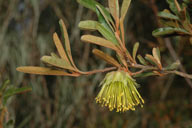In Flower This Week
A weekly news sheet prepared by a Gardens' volunteer.
Numbers before each plant refer to temporary IFTW labels in the gardens.
Numbers in square brackets [ ] refer to garden bed Sections. Plants in flower are in bold type.
View past issues of 'In Flower This Week'.
16 August 2013
Diplolaena microcephala
click for larger image |
This walk is in the Rock Garden, the route taken is in an anticlockwise direction. To arrive there follow the road on the far side of the Rainforest turning right at the connection of the Main Path which will reach the waterfall.
- At the entrance clusters of Rhodanthe anthemoides [Section 15c, 15d, 15s] are small plants clad with white buds opening to white daisy-like flowers, seen between the rocks.
- Guichenotia ledifolia [Section 4] is a rounded shrub of medium size, well covered with small pink downturned flowers.
- Diplolaena microcephala [Section 15r] is an open upright shrub with few remarkable yellow-green flowers.
- Edging the path Indigofera australis [Section 4] is laden with buds now opening to pink pea-shaped flowers.
- Almost opposite, a low-growing dense plant, Gastrolobium celsianum [Section 15r], displays its unusual red pea flowers.
- Take the narrow path seen between the coloured pots along which a Thryptomene sp. [Section 15r] is a low growing plant with long arching branches clad with tiny pink flowers.
- Almost opposite Baeckea crassifolia [Section 15r] is a small upright plant, so attractive with its dark-centred deeper pink flowers among the darker foliage.
- Follow this path to the sundial, turning right to view, next to a seat, a Grevillea sp. [Section 14] with red toothbrush-like flowers amid the indented leaves which flow down the rocks. This plant like many others has been damaged by our inclement weather.
- Returning along this path, pass Leucopogon neoanglicus [Section 15k], which is a low dense shrub. Amid the dark foliage are the tiny pink tube-shaped flowers with white mouths.
- Cauliflower Hakea, Hakea corymbosa [Section 15p], is a large rounded shrub, well manicured, with sharp pointed leaves and large terminal clusters of pale yellow flowers fading to brown.
- Beside this is Banksia fraseri var. fraseri [Section 15p] with flat yellow flower heads seen amid its narrow foliage.
- At the upper corner falling down the rocks, Banksia spinulosa ‘Birthday Candles’ [Section 15l] is dense with many golden flower spikes. Further along on the left [Section 15n], read about ‘A living growing experiment’ on an alpine research project display.
- Across the bridge, Banksia blechnifolia [Section 15d] is a prostrate plant with deeply lobed vertical leaves and pinkish immature flower spikes all arising from the ground.
- Find a wattle, Acacia pterocaulon [Section 15e], in a pot. This plant has numerous ever so long flattened branches with a few stems bearing bright yellow flower balls.
- Opposite are a few shrubs including Grevillea manglesii subsp. ornithopoda [Section 15d], a large shrub bearing cream lacy flowers.
- Grevillea speciosa subsp. dimorpha [Section 15d] is an upright many-branched shrub with red flowers edging its branches.
- Banksia ‘Honeypots’ [Section 15d] displays its honey-coloured flower spikes over the upright shrub.
- Nearby Correa ‘Ivory Bells’ [Section 15d] decorates its large shrub with ivory-coloured bell‑shaped tubular flowers.
These are other shrubs in flower among these rocks. Also there is a section of wattles over the road above that is worth exploring.
Barbara Daly
![Director of National Parks [logo]](../../../../images/dnp_90px.gif)







